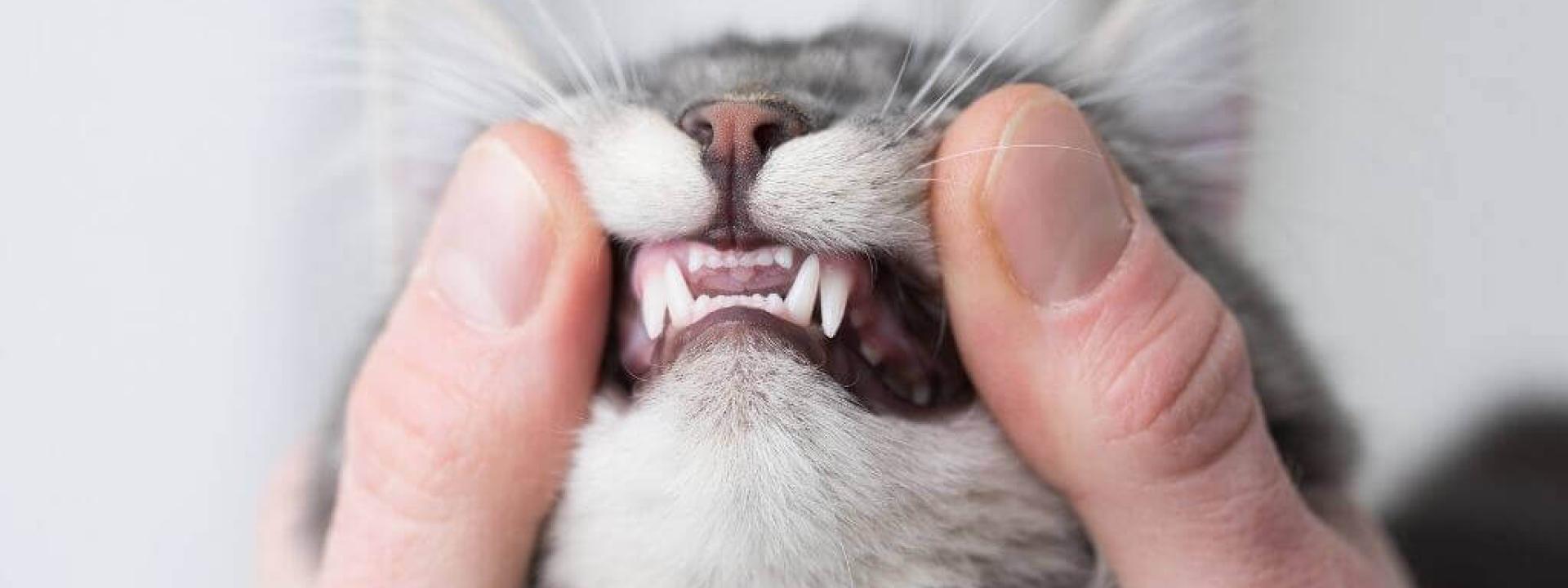While February is Pet Dental Health Month and the “official” time to get serious about caring for your cat’s teeth, your feline friend needs proper dental care all year long. Like people, cats can suffer from tooth and gum disease due to insufficient dental care. Unlike people, though, our feline friends have mastered the art of hiding signs of pain and discomfort. They tend to remain stoic even when in extreme pain, making it difficult to tell when something is wrong.
Although it can be difficult to discern if your cat’s mouth is painful, there are a few signs that could indicate something is amiss. As veterinarians, we believe that dental care is a crucial component of feline wellness care and are here to help if your cat’s teeth need some TLC. In this blog post, we’ll be discussing a few ways to tell if your cat’s mouth is painful and what to do about it. Let’s get started.
Symptoms of Dental Disease in Cats
Though cats do their best to hide signs of discomfort and pain, certain clues aren’t easy to keep under wraps.
Common signs of oral pain in cats include:
- Bad breath
- Changes in eating habits
- Excessive drooling
- Swollen and/or bleeding gums
- Tooth discoloration
- Facial swelling
- Nasal discharge or frequent sneezing
- Changes in behavior/hiding
- Decreased grooming
- Pawing at the mouth
Changes in eating habits or reluctance to eat are the most obvious signs of dental disease. Your cat may go to their bowl but refuse to eat due to pain. Or they may take just a few bites before giving up. Cats with dental disease may also drop food while trying to eat or even hiss at their food bowl after trying to eat.
Causes of Feline Oral Pain
Cats experience oral pain for several reasons.
The most common causes of feline tooth pain include:
- Gingivitis
- Periodontitis
- Tooth resorption
- Stomatitis
- Malocclusions
Gingivitis
Gingivitis, or swelling of the gums, causes pain where the gums and teeth meet. It can also cause redness, swelling, and, in severe cases, bleeding. It can also make it difficult for cats to eat dry food.
Periodontitis
When we don’t treat or control gingivitis, it can lead to periodontitis. In cats with periodontitis, bacteria and inflammation weaken the tissues that attach the teeth to the gums, eventually causing bone and tooth loss in most cases.
Tooth Resorption
Tooth resorption occurs as a result of a tooth’s structure breaking down. It begins inside the tooth and moves to other parts. It is the most common cause of feline tooth pain and loss and affects 30 to 70 percent of cats. Tooth resorption is hereditary and not related to oral hygiene.
Stomatitis
Stomatitis is extremely painful and occurs when an overactive immune system attacks plaque on the teeth. This causes redness, ulceration, and thickening of the oral cavity tissues, making it difficult for affected cats to eat.
Malocclusions
Occlusion refers to the relationship between the teeth of the upper and lower jaws. When the relationship between the two is abnormal, it causes an overbite/underbite or abnormal bite called malocclusion. In cats, malocclusion can cause pain and difficulty eating.
What to Do If Your Cat’s Mouth Is Painful
Seek prompt veterinary care if you have any reason to suspect that your cat may be experiencing tooth or gum pain. By the time your feline friend starts showing symptoms, they could be experiencing advanced periodontal disease and severe discomfort. Treating the underlying disease is the only way to eliminate the pain.
When you bring your cat to us for dental care, we’ll start by performing a comprehensive oral health exam while they are under general anesthesia. We’ll also ask you about your concerns and the symptoms that prompted you to schedule an appointment. We will carefully assess your cat’s teeth and take a close look at the gums during the exam. We’ll scale the tartar off the teeth to get a better look, and we will likely perform dental radiographs (x-rays). With x-rays, we can evaluate the condition of the roots and bone and look for problems below the gumline.
After cleaning and examining your pet’s oral cavity, we’ll come up with a treatment plan. This plan may include extracting severely damaged or diseased teeth or performing advanced procedures, like root canals. We may also prescribe oral medications, including antibiotics and/or pain medications.
Preventing Dental Problems in Cats
Ensuring that your cat receives regular dental care is the best way to prevent problems like tooth pain and infections. In addition to scheduling annual dental cleanings and exams with us, we recommend brushing your feline friend’s teeth at home. Ideally, you should do this daily. Daily brushing eliminates plaque before it can harden into tartar. If you are unsure how to brush your cat’s teeth safely, we’d be more than happy to teach you during their next appointment.
Closing Thoughts
Oral pain can significantly diminish your cat’s quality of life. In addition to causing extreme discomfort, tooth and gum disease can cause difficulty eating and a wide range of other health problems. Staying on top of your cat’s oral health is the best way to keep these problems at bay. If you think your feline friend may be suffering from mouth pain, contact us right away to schedule an appointment.

